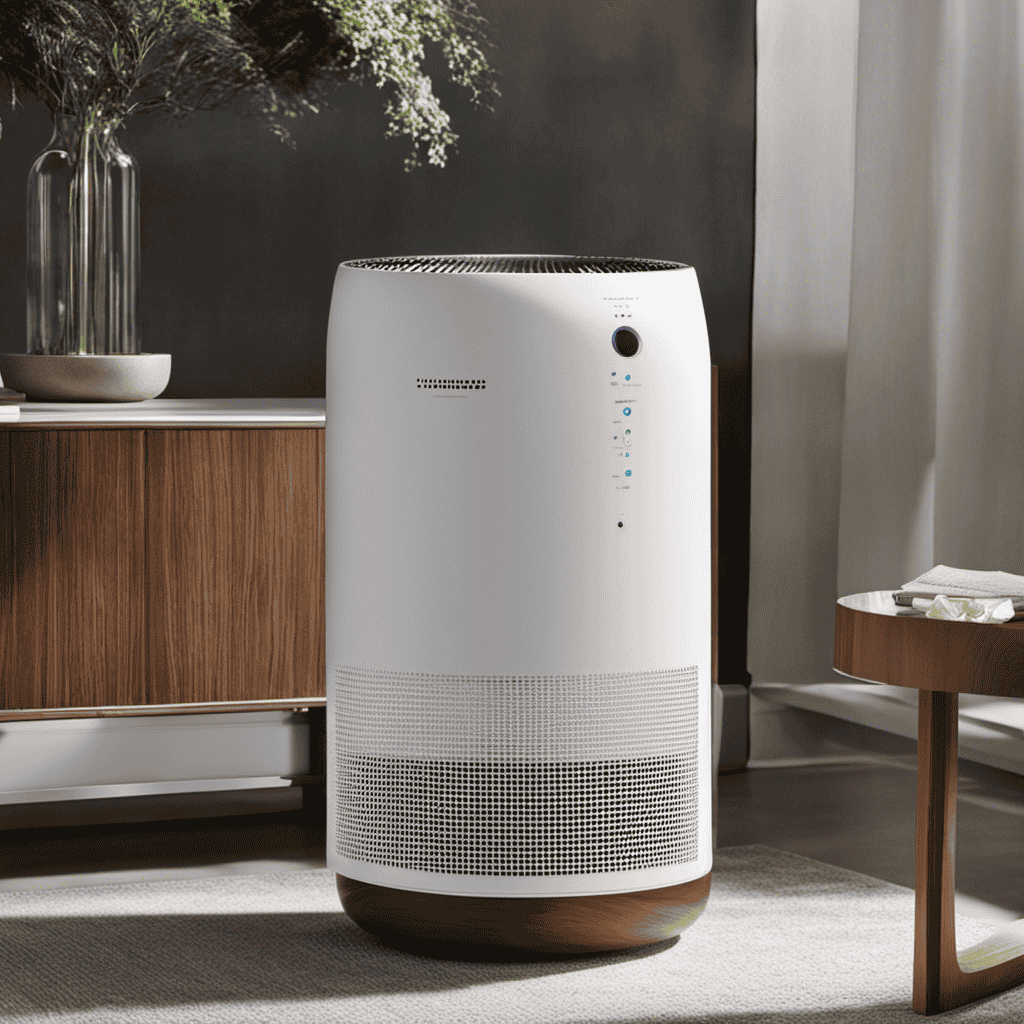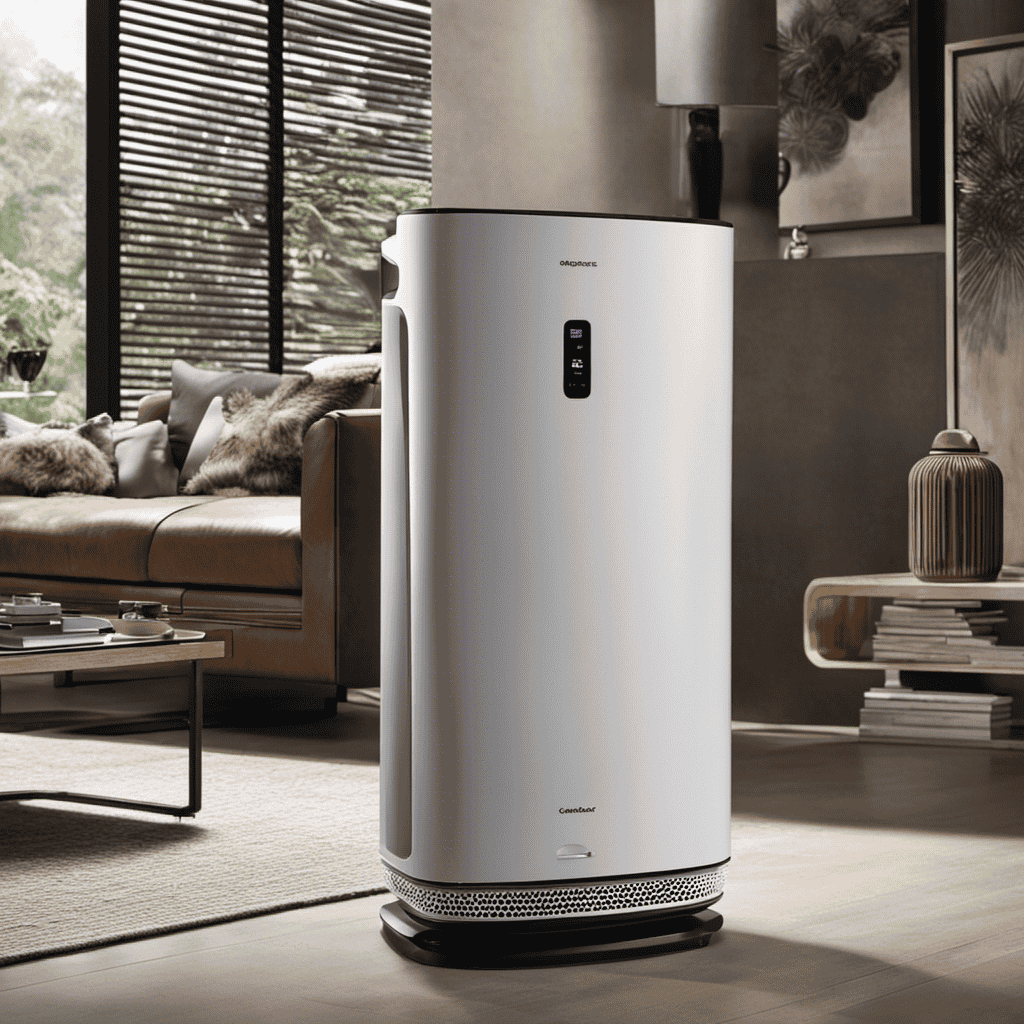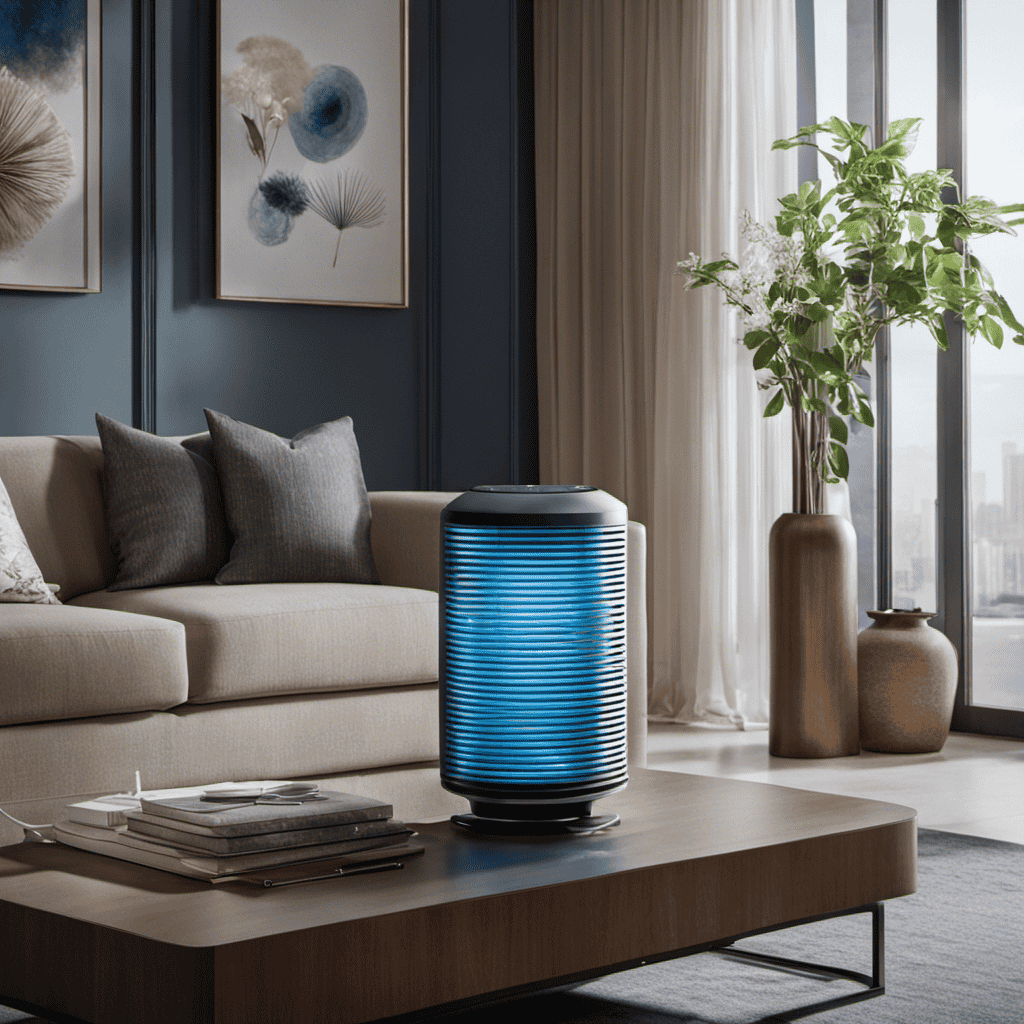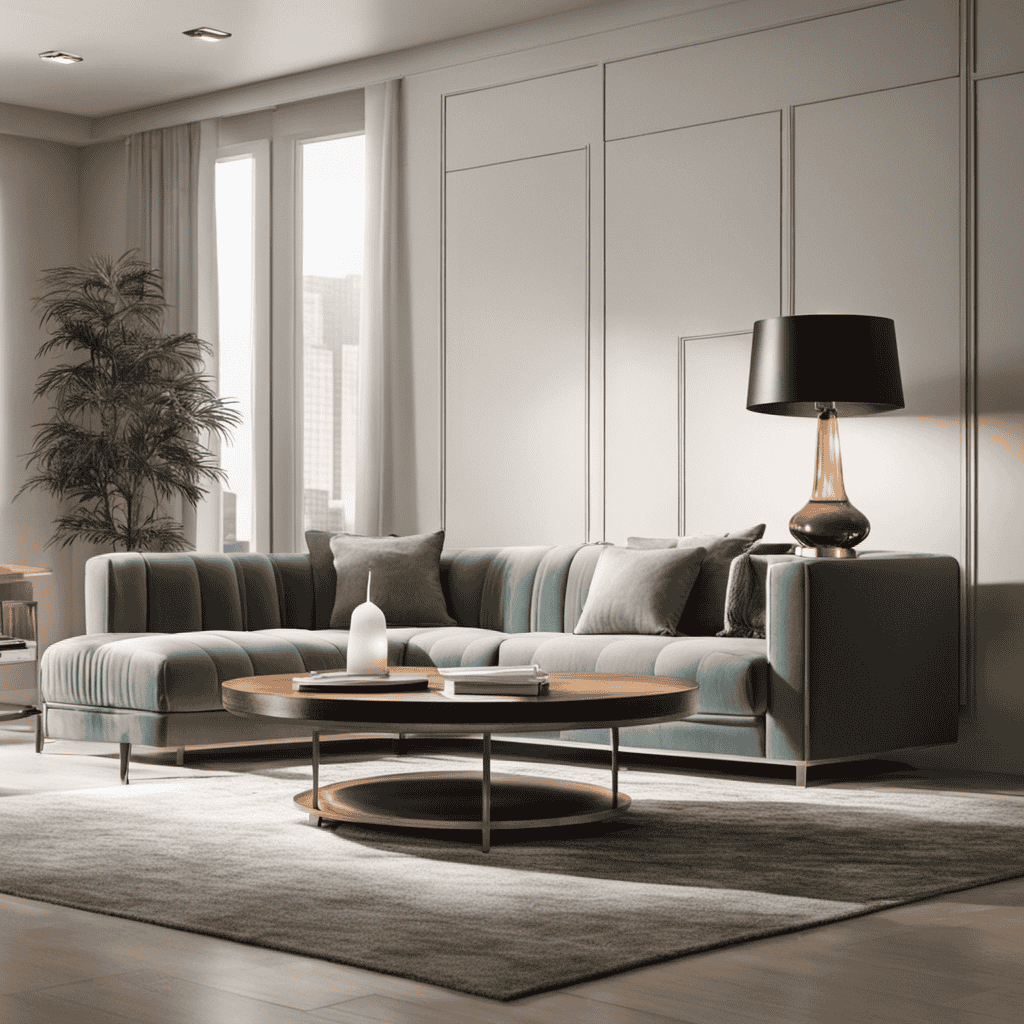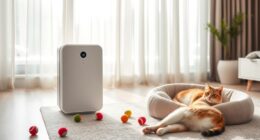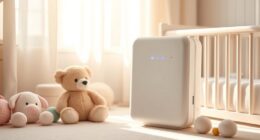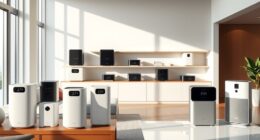You might be wondering, what exactly does hitting the HEPA reset on my air purifier accomplish? Allow me to explain, it involves more than merely pressing a button.
In this article, I’ll break down the functionality of HEPA filters and explain how the reset feature plays a crucial role in maintaining optimal air purification performance.
We’ll also explore common reasons for triggering the HEPA reset and provide you with a step-by-step guide on how to reset your air purifier.
So, let’s dive in and demystify HEPA reset once and for all.
Key Takeaways
- HEPA filters improve indoor air quality by trapping small particles such as dust, pollen, pet dander, bacteria, and viruses.
- Resetting the filter lifespan is important for accurate tracking and to ensure the air purifier can monitor usage accurately.
- Resetting the filter maximizes its usage and avoids premature replacement, saving money on unnecessary replacements.
- Properly resetting the filter ensures optimal performance, efficient filtration, and helps maintain clean and healthy air.
Explanation of HEPA Filter Functionality
The HEPA filter is an essential component of air purifiers, designed to improve the air we breathe. It helps trap and remove small particles from the air, giving you cleaner and fresher indoor air quality. HEPA stands for High-Efficiency Particulate Air, and it operates by forcing air through a fine mesh that captures harmful pollutants such as dust, pollen, pet dander, and even bacteria and viruses.
Regular maintenance and cleaning are required to ensure the optimal performance of the HEPA filter. This includes the resetting procedure, which involves replacing or cleaning the filter according to the manufacturer’s instructions. By doing so, you can maximize the benefits of HEPA filters, such as reducing allergies, asthma triggers, and improving overall respiratory health.
Understanding the Reset Feature
When it comes to air purifiers, resetting the filter lifespan is an important aspect to consider. The reset feature allows the device to accurately track the usage of the filters and notify you when it’s time for a replacement.
Understanding why the reset is necessary and the correct reset procedure ensures the effectiveness and longevity of your air purifier.
Resetting Filter Lifespan
To reset the filter lifespan on your air purifier, follow the instructions in your user manual. Proper filter maintenance is crucial for clean air quality and optimal performance. Regular filter replacement is necessary to effectively remove pollutants. Most air purifiers have a filter replacement indicator that alerts you when it’s time to change the filter. Resetting the filter lifespan is a simple process involving pressing and holding a specific button or combination of buttons on the control panel. This action will reset the filter replacement indicator, allowing you to track your new filter’s lifespan accurately. Refer to your user manual for the manufacturer’s recommended filter replacement schedule and instructions.
Why Reset Necessary
If you want your filter to accurately track its lifespan, it’s important to reset it when necessary. Resetting the filter helps ensure that your air purifier continues to provide clean and healthy air. Here are some reasons why resetting is necessary:
- Increased filter lifespan: By resetting the filter, you can maximize its usage and avoid premature replacement.
- Optimal performance: Resetting the filter allows the air purifier to accurately monitor its usage, ensuring it operates at its best.
- Efficient filtration: A properly reset filter ensures that the air purifier removes contaminants effectively, maintaining indoor air quality.
- Cost savings: Resetting the filter when needed helps you avoid unnecessary filter replacements, saving you money in the long run.
To reset the filter, follow the correct reset procedure, which we will discuss in the next section. But first, let’s explore troubleshooting tips for common reset issues.
Correct Reset Procedure?
Follow these steps to ensure you’re performing the correct reset procedure for your filter.
Resetting your air purifier’s filter is essential when encountering any resetting problems. To troubleshoot these issues, it is crucial to know the correct reset procedure.
First, locate the reset button on your air purifier. It is typically found on the control panel or near the filter compartment.
Press and hold the reset button for 5-10 seconds until you see the reset indicator light turn off or hear a beep sound. This indicates that the filter has been successfully reset.
If the reset does not solve the problem, consult the user manual or contact customer support for further troubleshooting tips.
How Resetting Affects Air Purification Performance
When it comes to air purifiers, understanding the impact of resetting on filtration efficiency is crucial. Resetting the filters can have a direct effect on the overall performance of the air purification system, as it determines how effectively the filters are able to capture and remove pollutants from the air.
Additionally, it is important to follow the recommended reset frequency to ensure that the filters are functioning optimally and maintaining their efficiency over time.
Impact on Filtration Efficiency
The hepa reset feature on your air purifier doesn’t affect the filtration efficiency. It is designed to reset the filter replacement indicator, which helps you keep track of when it’s time to change the filter. However, it is important to understand the impact of this feature on energy consumption and air quality.
Here are some key points to consider:
-
Energy consumption: The hepa reset feature itself does not directly impact energy consumption. However, using an air purifier continuously without changing the filter when needed can lead to reduced efficiency and increased energy usage over time.
-
Air quality: Resetting the filter replacement indicator ensures that the air purifier continues to operate at optimal performance. By regularly replacing the filter, you can maintain a high level of air quality and effectively remove pollutants from your indoor environment.
-
Maintenance: The hepa reset feature simplifies maintenance by reminding you to change the filter. This ensures that your air purifier continues to function efficiently and effectively.
-
Longevity: Regularly replacing the filter not only improves air quality but also extends the lifespan of your air purifier, reducing the need for frequent replacements.
Reset Frequency Recommendations
To ensure optimal performance, you should regularly check the filter replacement indicator and reset it when necessary.
The frequency of resetting the filter indicator will depend on several factors, such as the type of air purifier you have and the usage patterns.
Generally, it is recommended to reset the filter indicator every time you replace the filter. This ensures that the indicator accurately reflects the filter’s lifespan and helps you maintain good air quality.
Neglecting to reset the filter indicator can lead to inaccurate readings and potential issues with the air purifier’s performance.
It is important to follow the manufacturer’s recommendations for resetting the filter indicator to ensure that your air purifier functions at its best.
Now, let’s dive into the topic of resetting vs. replacing filters and explore their differences.
Resetting Vs. Replacing Filters
Resetting and replacing filters are two key maintenance tasks that ensure the proper functioning of your air purifier. When it comes to maintaining your air purifier, it is essential to understand the difference between resetting filters and filter replacement.
While resetting filters involves restoring the filter’s timer or indicator, filter replacement involves physically replacing the old filter with a new one. Here are some important things to consider:
- Regularly resetting filters helps in keeping track of the filter’s lifespan and ensuring timely replacement.
- Filter replacement is necessary when the filter becomes dirty, clogged, or damaged.
- Neglecting to reset filters or replace them can compromise the air purifier’s performance and decrease its effectiveness in removing pollutants.
- Following the manufacturer’s instructions for resetting and replacing filters is crucial to maintain the air purifier’s optimal functioning.
Common Reasons for Triggering the HEPA Reset
One common reason for triggering the HEPA reset is if the filter becomes clogged. When the HEPA filter gets clogged with dust, pollen, or other particles, it can hinder the air purifier’s performance and reduce its effectiveness.
The HEPA reset function is designed to alert users when the filter needs to be cleaned or replaced. To troubleshoot this issue, you can start by checking the filter for any visible dirt or debris. If the filter appears dirty, it may need to be cleaned or replaced. Cleaning instructions can usually be found in the air purifier’s user manual.
Additionally, make sure that the air purifier is placed in an area with sufficient airflow and that the intake vents are not blocked. Regularly maintaining and replacing the filter can help ensure optimal performance of your air purifier.
Step-by-Step Guide to Resetting Your Air Purifier
Follow these simple steps to easily reset your air purifier and get it back up and running smoothly.
To reset your air purifier, you’ll need to follow these steps:
-
First, unplug the air purifier from the power source. This will ensure your safety while performing the reset.
-
Next, locate the reset button on your air purifier. It is usually located on the control panel or on the back of the unit.
-
Press and hold the reset button for at least 10 seconds. This will reset the air purifier and clear any error codes or issues that may be causing it to malfunction.
-
Finally, plug the air purifier back into the power source and turn it on. It should now be reset and ready to use.
By following these steps, you can easily reset your air purifier and resolve any issues you may be experiencing.
Now, let’s discuss the best practices for maintaining the HEPA reset function.
Best Practices for Maintaining the HEPA Reset Function
To ensure optimal performance, it’s important to regularly clean and replace the filters in your air purifier. This not only helps to maintain the air quality in your home, but also ensures that the HEPA reset function continues to work effectively. The HEPA reset function is responsible for resetting the filter life indicator after a new filter has been installed. By keeping the filters clean and replacing them as recommended by the manufacturer, you can ensure that the HEPA reset function works properly and accurately reflects the filter’s actual lifespan.
| Cleaning Frequency | Filter Replacement Frequency |
|---|---|
| Every 2 weeks | Every 6 months |
Troubleshooting Tips for HEPA Reset Issues
If you’re experiencing issues with the HEPA reset function, try unplugging the air purifier for a few minutes and then plugging it back in to see if that resolves the problem. Troubleshooting HEPA reset errors can be frustrating, but there are a few steps you can take to address the issue.
Here are some tips to help you reset the HEPA filter timer and get your air purifier back up and running smoothly:
-
Check the power source: Ensure that the air purifier is properly plugged in and receiving power. Sometimes, a loose connection can cause the HEPA reset function to malfunction.
-
Clean the air filter: A clogged or dirty air filter can interfere with the HEPA reset process. Remove the filter and clean it according to the manufacturer’s instructions.
-
Reset the device: Some air purifiers have a dedicated reset button or a combination of buttons that need to be pressed to reset the HEPA filter timer. Refer to the user manual for specific instructions.
-
Contact customer support: If you’ve tried the above steps and are still experiencing issues with the HEPA reset function, reach out to the manufacturer’s customer support for further assistance.
Frequently Asked Questions
Can I Use My Air Purifier Without Resetting the HEPA Filter?
Yes, you can use your air purifier without resetting the HEPA filter. However, it is important to understand that regular filter maintenance is crucial for optimal performance. Alternative air filtration methods may also be considered.
How Often Should I Reset the HEPA Filter on My Air Purifier?
I can go without resetting the HEPA filter on my air purifier for about 6-12 months, but it’s beneficial to do it regularly. Regularly resetting the HEPA filter ensures optimal performance and helps maintain clean air quality in your home.
Will Resetting the HEPA Filter Improve the Air Purification Performance of My Air Purifier?
Resetting the HEPA filter on my air purifier can improve the air purification performance. By resetting, the filter is cleared of accumulated particles, allowing it to efficiently capture and remove airborne contaminants.
What Happens if I Don’t Reset the HEPA Filter on My Air Purifier?
Not resetting the HEPA filter on my air purifier can have consequences. It may reduce the efficiency of air purification, resulting in poorer air quality. Alternatives include cleaning or replacing the filter regularly.
Can I Reset the HEPA Filter on My Air Purifier Multiple Times in a Row to Enhance Its Effectiveness?
Resetting the HEPA filter on my air purifier multiple times in a row does not enhance its effectiveness. It is recommended to follow the manufacturer’s guidelines for resetting frequency to maintain optimal performance and air quality.
Conclusion
In conclusion, the HEPA reset feature on air purifiers plays a crucial role in maintaining optimal air purification performance. By resetting the filter, it ensures that the device continues to operate effectively and removes harmful particles from the air.
Interestingly, studies have shown that air purifiers with HEPA filters can improve indoor air quality by removing up to 99.97% of airborne particles as small as 0.3 microns. Therefore, regularly resetting your air purifier is essential for enjoying clean and healthy air in your home or office.
